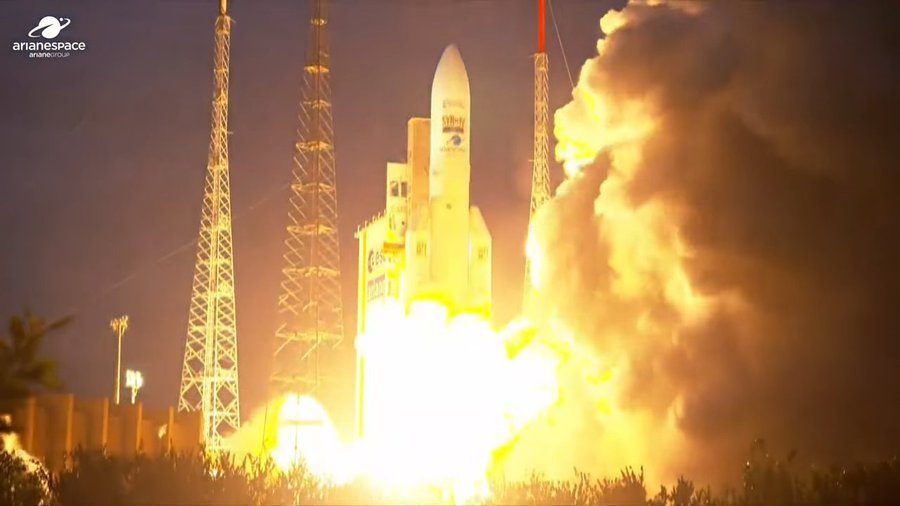The 117th and last Ariane 5, flight VA261 using the Ariane 5 ECA+ variant, successfully lifted off from the ELA3 pad at Kourou, French Guiana, at 2200 GMT on 5 July. The rocket was carrying two communications satellites: Germany’s H2SAT (Heinrich Hertz) and France’s military comsat Syracuse 4B. Both were successfully placed into their Geosynchronous Transfer Orbit (GTO) from which they will circularise themselves into their respective geostationary orbital positions.
Syracuse 4B, aka Comsat NG2, employs an “all-electric” Airbus-built Eurostar E3000e (EOR) bus platform to provide X- and Ka-band communications to the French military so that the French Armed Forces can remain permanently connected during deployments. Fitted with state-of-the-art equipment (anti-jamming antenna, digital processor, etc), Syracuse 4B will be totally protected against the most extreme jamming methods. The satellite will also be able to support operations led by NATO and the EU.
H2SAT (Heinrich Hertz) is an experimental communications satellite for Germany serving both civil and governmental markets. It is the first dedicated German communications satellite for researching and testing new technologies and communications scenarios. The satellite carries various communications technology experiments and will test new “payload flexibility” technologies. It uses the OHB-built SmallGEO bus.
The final Ariane 5 was supposed to fly after the debut of its successor. However, for technical reasons, the entrance of Ariane 6 to the market has been delayed.

The final Ariane 5 launch. Courtesy: Arianespace
Comment by David Todd: Ariane 5 has, for the most part, had a successful career – albeit one that started inauspiciously in June 1996 with an embarrassing guidance related maiden flight failure, losing four ESA Cluster spacecraft. Later issues ranged from total failures to orbit, caused by engine problems with new Ariane 5 variants, to having satellites sent to the wrong place by a targeting error, or being damaged by the fairing during flight. Ultimately the Ariane 5 family never matched its original reliability target of 98.5 per cent successful launches.
According to the Seradata launch and spacecraft database, it actually achieved a failure rate of 94 per cent on a raw failures versus flights basis (seven failures out of 117 flights). A launcher related failure is defined as any satellite payload not reaching its planned orbital position in an undamaged state due to the launch vehicle. Ariane 5’s achieved success rate gets closer if the actual capability lost is used as a modifier: then the success rate approaches 97.5 per cent. This rate is regarded in the space industry as very good (albeit still laughably poor compared with the airline industry).
The cost of an Ariane 5 launch, which came in at well over US$200 million (US$100 million for each satellite on an equal dual launch), was a trickier problem for Arianespace. As SpaceX began offering large satellite rides to orbit on the partly reusable, and highly reliable, Falcon 9 for less than US$70 million, Ariane 5 became increasingly uncompetitive. The cost differential was the main reason why the expendable Ariane 6 was started by ESA, Arianespace and the Ariane Group, although it is still unlikely to achieve price parity with the Falcon 9 and the completely reusable Starship successor. In contrast, Ariane 6 has been criticised for not being in any way reusable and thereby costing more. ESA’s “Juste Retour” workshare arrangement, whereby investor nations get a portion of the construction work, has also somewhat stymied attempts to drive costs down. This factor dogged the Ariane 5 in much the same way that it is now troubling the economics of the Ariane 6.
Nevertheless, Ariane 5, costly as it may have been, has been a technical and – for much of its life – a commercial success. It deserves our salute as it leaves the stage.





